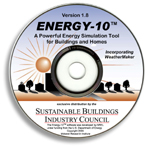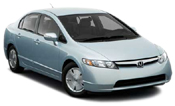Update of Sustainable Buildings Industry Council Software Has New PV Module
The Sustainable Buildings Industry Council released version 1.8 of its ENERGY-10 software, which helps builders identify the best combination of nearly one dozen energy-efficient strategies, including daylighting controls, passive solar heating and high-efficiency mechanical systems. According to the Council, the new software features a photovoltaic module that provides the ability to model and simulate the performance of a photovoltaic system that is either stand-alone or integrated with a building; a solar domestic hot water module; and a new library that defines constructions as spelled out in American Society of Heating, Refrigerating and Air-Conditioning Engineers Standard 90.1-2004. For more information, contact Douglas Schroeder at dschroeder@sbicouncil.org or phone 202-628-7400 ext 210. |
Consumer Reports: Two Hybrids Pay for Themselves in Gas Savings
Consumer Reports announced a rare revision of one of its articles in March 2006, correcting a story that found the extra cost of hybrid vehicles is not reclaimed through savings on gasoline.
In fact, a recalculation by the magazine concluded that the Toyota Prius and the Honda Civic Hybrid will save their owners about $400 and $300, respectively, over the first five years and 75,000 miles of driving, thanks in part to federal tax credits. Other hybrids would cost their owners from $1,900 to $5,500 more than their gasoline-only counterparts. However, some states offer incentives that tip the scale more in favor of hybrid vehicles, a factor not accounted for by the magazine. Honda Civic Hybrid will save their owners about $400 and $300, respectively, over the first five years and 75,000 miles of driving, thanks in part to federal tax credits. Other hybrids would cost their owners from $1,900 to $5,500 more than their gasoline-only counterparts. However, some states offer incentives that tip the scale more in favor of hybrid vehicles, a factor not accounted for by the magazine.
Anyone considering buying a hybrid vehicle should check the web site of the American Council for an Energy Efficient Economy, which includes estimates of the federal tax credit for all current and upcoming hybrids. On the state level, the U.S. Department of Energy's Alternative Fuels Data Center lists the incentives available for hybrids and alternative fuel vehicles. Buying a hybrid can also cut the cost of your auto insurance: Travelers is offering a 10 percent discount in 26 states and the District of Columbia, and will expand the discount to more states later in 2006.
Department of Energy Wants to Cut Energy Use in Dishwashers
The U.S. Department of Energy in December 2005 announced more stringent energy efficient criteria for dishwashers carrying the ENERGY STAR label that could save America families more than $26 million a year. The new qualifying levels go into effect on January 1, 2007.
Dishwashers that meet the new ENERGY STAR criteria  must be a minimum of 41 percent more efficient than federal energy efficiency standards, and would save over 160 million kilowatt hours of energy per year, enough to light every household in Washington, D.C., for six months. must be a minimum of 41 percent more efficient than federal energy efficiency standards, and would save over 160 million kilowatt hours of energy per year, enough to light every household in Washington, D.C., for six months.
The ENERGY STAR label appears on more than 40 kinds of consumer products. Learn more at the ENERGY STAR web site or call 1-888-STAR-YES.
|
|
Zero-Energy Homes Could Save 19% of U.S. Residential Energy by 2050
The concept of zero-energy homes could enter the U.S. housing market by 2012 and save 19 percent of all energy consumption in single-family homes by 2050.
“Zero energy homes are technically feasible today,” says the National Association of Home Builders in its study, The Potential Impact of Zero Energy Homes. The National Association of Home Builders Research Center developed the report with the U.S. Department of Energy and the National Renewable Energy Laboratory to examine the long-term outlook for Zero Energy Home technologies in the new home market and their potential impact on U.S. energy consumption.
Zero energy homes are connected to the grid, and combine energy-efficient design and technology with solar electric and thermal systems to produce as much energy as they use on an annual basis, resulting in net zero energy consumption. The first Zero Energy Home in the U.S. was built in Arizona in 2003.
An increase in popularity of ‘ENERGY STAR’ homes indicates that home buyers are starting to embrace many concepts behind Zero Energy Homes, the report explains. The first ENERGY STAR home was built in 1995 and 130,000 built in 2004, with 40 percent penetration in some markets.
Tax credits and other financial incentives for both home-buyers and home-builders are essential for near-term market adoption of Zero Energy Homes, and market acceptance of the concept among both groups is “crucial to its adoption by the U.S. housing industry,” the report concludes. |
Research Shows Ventilated Auto Seats Improve Fuel Economy and Comfort
The U.S. Department of Energy's National Renewable Energy Laboratory has demonstrated that ventilated automotive seats improve passenger comfort and a vehicle's fuel economy. That's because ventilated seats keep drivers and passengers cooler, so they need less air conditioning to be comfortable.
The Laboratory’s Vehicle Ancillary Loads Reduction team worked with industry to try to reduce fuel consumption from air conditioning in cars and trucks. The use of ventilated seating is one way to cut air conditioning. Recent research shows if all passenger vehicles had ventilated seats, there could be a 7.5 percent reduction in national air-conditioning fuel use. That translates to a savings of 522 million gallons of fuel a year.
Using its suite of thermal comfort tools and subjective test data, the laboratory measured improvement in human thermal sensation for the ventilated seats and the potential for a 7 percent reduction in air-conditioning compressor power. General Motors currently offers this ventilated seat as an option for the Cadillac STS.
The National Renewable Energy Laboratory is the U.S. Department of Energy's primary national laboratory for renewable energy and energy efficiency research and development.
Schools Curb Energy Costs by Building Green
Energy bills are eating up millions of dollars from school budgets. To combat this problem, a school in Salem, Oregon is demonstrating that classrooms can be built — or retrofitted at competitive costs — with no needs fore artificial lighting during the day. According to an article in the January 4, 2006 issue of The Oregonian, the school uses a large skylight and other technologies to enhance and regulate the natural light coming into the space. The article also highlights a Portland, Oregon school district, which spent more than $6 million for lighting and heating in the last school year. Now the school is reporting significant energy savings thanks to adopting green-building techniques, from using groundwater for heating and cooling to installing natural ventilation systems.
|

 Honda Civic Hybrid will save their owners about $400 and $300, respectively, over the first five years and 75,000 miles of driving, thanks in part to federal tax credits. Other hybrids would cost their owners from $1,900 to $5,500 more than their gasoline-only counterparts. However, some states offer incentives that tip the scale more in favor of hybrid vehicles, a factor not accounted for by the magazine.
Honda Civic Hybrid will save their owners about $400 and $300, respectively, over the first five years and 75,000 miles of driving, thanks in part to federal tax credits. Other hybrids would cost their owners from $1,900 to $5,500 more than their gasoline-only counterparts. However, some states offer incentives that tip the scale more in favor of hybrid vehicles, a factor not accounted for by the magazine.  must be a minimum of 41 percent more efficient than federal energy efficiency standards, and would save over 160 million kilowatt hours of energy per year, enough to light every household in Washington, D.C., for six months.
must be a minimum of 41 percent more efficient than federal energy efficiency standards, and would save over 160 million kilowatt hours of energy per year, enough to light every household in Washington, D.C., for six months.